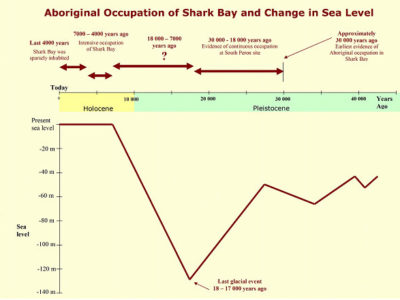Periods of Occupation
Aboriginal people first inhabited Shark Bay some 30,000 years ago and moved to and from the area in response to changing sea levels and availability of fresh water and food.
A site near Eagle Bluff shows two periods of occupation, the first during the late Pleistocene between 30,000 and 18,000 years ago, and then during the Holocene about 7,000 to 6,000 years ago.
Sites at Monkey Mia and Useless Loop show the current period of occupation beginning about 2,300 years ago, while rock shelters at Eagle Bluff and on the Zuytdorp Cliffs are up to 4,600 years old.
The late Pleistocene was characterised by cold glacial and warm interglacial periods. Sea levels rose when glaciers melted, then fell during cold periods when water was locked up in ice. The more recent Holocene has been a warm interglacial period.
Archaeologists believe people may have moved away from Shark Bay during glacial periods when the sea level was lower and fresh water limited. The types of food available would also have been affected by the lower sea levels.
Sea level rises during interglacial periods would have flooded previously occupied sites, making them unsuitable for living and possibly removing evidence of their occupation. There would have been a resurgence of mangroves and shellfish when the sea reached its present level 7,000 to 4,000 years ago.

